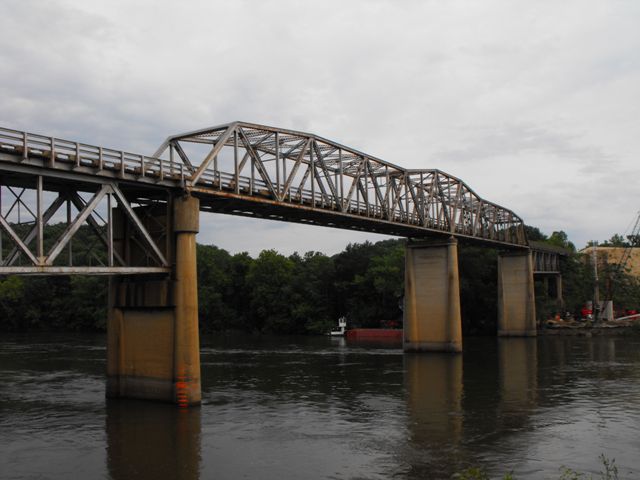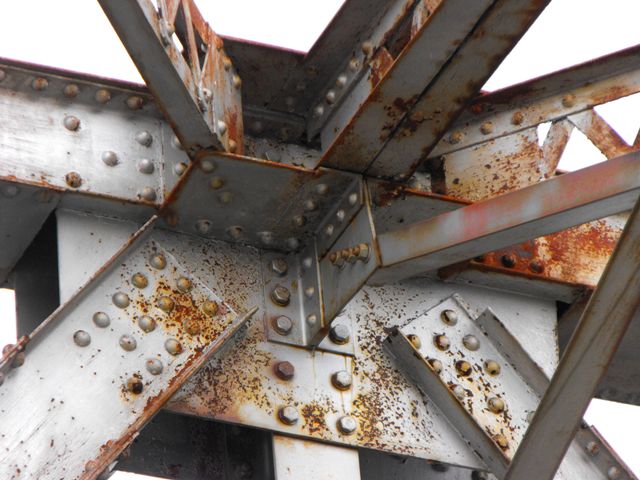We Recommend:
Bach Steel - Experts at historic truss bridge restoration.
Tuscumbia Bridge

Primary Photographer(s): Nathan Holth and Rick McOmber
Bridge Documented: July 3, 2009
Tuscumbia: Miller County, Missouri: United States
Metal Continuous 10 Panel Rivet-Connected Warren Through Truss, Fixed and Approach Spans: Metal 10 Panel Rivet-Connected Warren Deck Truss, Fixed
1932 By Builder/Contractor: Industrial Construction Company of St. Louis, Missouri and Engineer/Design: Missouri State Highway Commission
Not Available or Not Applicable
200.0 Feet (61 Meters)
1,084.0 Feet (330.4 Meters)
20 Feet (6.1 Meters)
2 Main Span(s) and 10 Approach Span(s)
5496

View Information About HSR Ratings
Bridge Documentation
This bridge no longer exists!
View Archived National Bridge Inventory Report - Has Additional Details and Evaluation
View The Original Site Plans For This Historic Bridge
This historic bridge was demolished 9:00 AM CDT, August 31, 2010 by MoDOT!
Vew Historic Bridge Recordation For This Bridge
The Tuscumbia Bridge is a rare example of a smaller scale continuous through truss bridge. The bridge also contains a number of deck truss and stringer approach spans, adding to its significance as a complex and noteworthy engineering and construction achievement. Finally, the bridge is built at an incline (specifically, a 5% grade), which adds even further to its rarity and engineering significance. The bridge retains excellent historic integrity and is a good representative example of its type. Click the above drawing to get a detailed diagram showing span lengths and other measurements for the bridge.
This bridge has been described in many sources as a cantilever truss bridge, but it in fact appears to lack hinges and therefore functions as a continuous truss. It may have been built using the cantilever method, but it does not appear to be a cantilever truss bridge. The original plans describe the two main spans as continuous trusses.

The Tuscumbia Bridge has been a victim of the 2008-2009 economic recession. The Obama Administration and MoDOT both worked to make the replacement and demolition of this historic bridge the very first project to be started under the federal stimulus funds that were made available by the federal government in response to the recession. Ground was broken minutes after the bill was signed into law. The Obama Administration, MoDOT, and all involved media all failed to mention even a single time that the Tuscumbia Bridge they were replacing was historic and eligible for listing on the National Register of Historic Places. How convenient.
Cantilever and continuous truss bridges are among the most threatened forms of historic bridge in the country. Only a limited number were ever built in the country because they tended to be used for large crossings which limits the number built both as a result of the smaller number of rivers this large as well as the cost of constructing a large bridge. Worse, these bridges are being demolished and replaced with distasteful modern structures at an alarming rate. The larger cantilevers and continuous bridges are all being replaced with mundane cable-stayed bridges with no heritage value, while smaller cantilevers like the Tuscumbia Bridge are being replaced with structures that look like little more than a slab of concrete.
The Tuscumbia Bridge is a beautiful historic bridge which has not been treated the way it deserves. Over the years, it was not properly maintained, and deck, superstructure, and substructure all deteriorated as a result. All bridges, but particularly bridges eligible or listed in the National Register of Historic Places, should be carefully and constantly maintained to preserve the important historic structure, and also for reasons of fiscal responsibility. Maintaining an existing bridge is much less costly than demolition and replacement, and it also shows a commitment to environmental sustainability. Despite its deterioration, this bridge could still have been rehabilitated for continued vehicular use. Alternatively, it could have been preserved for pedestrian use next to its replacement. Indeed an unique linear park could have been created on the bridge going beyond simply including a non-motorized trail on the deck, but also fitting the deck with picnic tables, interpretive signage, etc.
This historic bridge deserves so much more than being melted down in a steel mill. This bridge should have been left standing next to its replacement as a historic landmark. It was not in the way of its replacement, and as such the demolition of this bridge does little more than waste taxpayer dollars and fill the pockets of those who stand to gain from the scrap steel. There is nothing more senseless and wasteful than the demolition of a historic bridge that is not in the way of its replacement. It also shows that anyone interested in historic bridges is being treated unfairly in this country. In the United State, people who want a replacement bridge have a right to get that replacement. However, people who want a historic bridge have no right to have a historic bridge unless they are millionaires and can buy the bridge and relocate it. All it would take to bring equality to our transportation system is to leave the historic bridge standing next to its replacement. Just delete the line in the contract that says "remove existing bridge," and suddenly everyone can get what they want. People who want a new bridge get a new bridge. People who want a historic bridge get to continue to have a historic bridge.
The replacement bridge has the appearance of little more than a slab of concrete. It is ugly in the most extreme sense imaginable, an irreparable scar upon a once-beautiful setting. No longer will the site be a scene of natural beauty of a river united with the beauty of a man-made transportation facility. Photos of the replacement bridge are available in the photo gallery. These photos show not only how ugly the new bridge is, but also how the historic bridge was not in the way of its replacement and should have been left standing.

Above: Still frame from a MoDOT video showing the demolition of the historic bridge.
Information and Findings From Missouri's Historic Bridge InventoryBridge Features Superstructure: steel, rigid-connected cantilever through
truss with 5-panel, rigid-connected Warren deck truss approach span at each
end; 6 span steel stringer approach at north end Discussion of Bridge Carrying Missouri State Highway 17 over the Osage River, this two-span steel truss is located in the county seat of Tuscumbia. Configured as a five-panel riveted cantilevered through truss with six steel stringer approach spans on the north, the structure rests on concrete abutments and bullnosed and spill-through piers. The bridge's history dates to 1932, when the Missouri State Highway Department let a construction contract to the Industrial Construction Company for the sum of $109,112.80. Designed by the state highway commission and utilizing steel components rolled in Illinois by the Inland Steel Company, the structure was erected without incident and continues to carry traffic in essentially unaltered condition. Opened to traffic in 1933, the Osage River Bridge facilitated highway traffic in central Missouri. It is thus historically significant for its role in the development of overland transportation in the region. The Osage River Bridge is technologically significant as a well-preserved, small-scale example of cantilevered truss construction in Missouri. It is one of only a handful of such major trusses found in the state away from the Mississippi and Missouri rivers. Bridge Considered Historic By Survey: Yes |
![]()
Photo Galleries and Videos: Tuscumbia Bridge
Structure Overview
Original / Full Size PhotosA collection of overview photos that show the bridge as a whole and general areas of the bridge. This gallery offers photos in the highest available resolution and file size in a touch-friendly popup viewer.
Alternatively, Browse Without Using Viewer
![]()
Structure Details
Original / Full Size PhotosA collection of detail photos that document the parts, construction, and condition of the bridge. This gallery offers photos in the highest available resolution and file size in a touch-friendly popup viewer.
Alternatively, Browse Without Using Viewer
![]()
Structure Overview
Mobile Optimized PhotosA collection of overview photos that show the bridge as a whole and general areas of the bridge. This gallery features data-friendly, fast-loading photos in a touch-friendly popup viewer.
Alternatively, Browse Without Using Viewer
![]()
Structure Details
Mobile Optimized PhotosA collection of detail photos that document the parts, construction, and condition of the bridge. This gallery features data-friendly, fast-loading photos in a touch-friendly popup viewer.
Alternatively, Browse Without Using Viewer
![]()
Northbound Bridge Crossing
Full Motion VideoStreaming video of the bridge. Also includes a higher quality downloadable video for greater clarity or offline viewing.
![]()
Bridge Demolition
Full Motion VideoHD Video Courtesy Missouri Department of Transportation. Video showing the implosion of the historic bridge and footage of the wreckage after the implosion. This video is rated EV for extreme violence toward innocent historic bridges. Viewer discretion is advised. Historic bridges WERE harmed in the making of this film. Streaming video of the bridge. Also includes a higher quality downloadable video for greater clarity or offline viewing.
![]()
Maps and Links: Tuscumbia Bridge
This historic bridge has been demolished. This map is shown for reference purposes only.
Coordinates (Latitude, Longitude):
Search For Additional Bridge Listings:
Bridgehunter.com: View listed bridges within 0.5 miles (0.8 kilometers) of this bridge.
Bridgehunter.com: View listed bridges within 10 miles (16 kilometers) of this bridge.
Additional Maps:
Google Streetview (If Available)
GeoHack (Additional Links and Coordinates)
Apple Maps (Via DuckDuckGo Search)
Apple Maps (Apple devices only)
Android: Open Location In Your Map or GPS App
Flickr Gallery (Find Nearby Photos)
Wikimedia Commons (Find Nearby Photos)
Directions Via Sygic For Android
Directions Via Sygic For iOS and Android Dolphin Browser
USGS National Map (United States Only)
Historical USGS Topo Maps (United States Only)
Historic Aerials (United States Only)
CalTopo Maps (United States Only)







